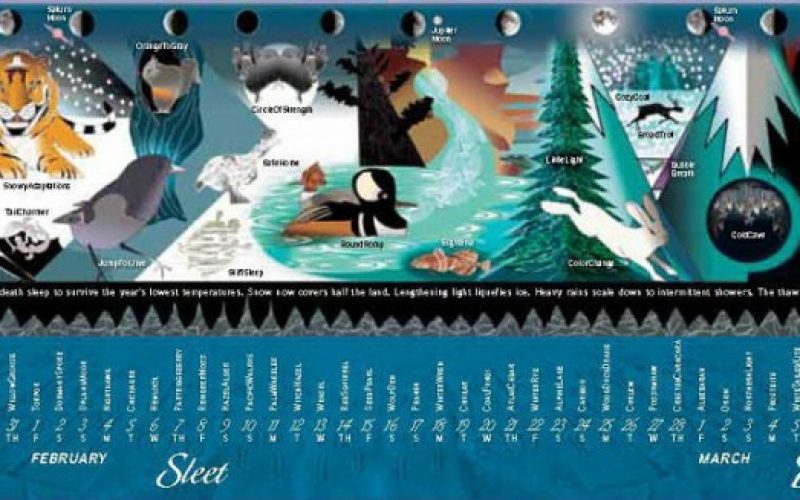
Courtesy Photo
Ecological calendar tracks the natural cycles of the Earth rather than the solar months of the traditional Gregorian calendar.
Our days are numbered. But numbering them on the conventional calendar has removed us from humanity’s place in time and natural cycles throughout the year. Originally, calendars helped people stay in sync with the natural solar year (365 ¼ days long) but rapid industrial progress has made calendars an endless stream of tasks, appointments, and holidays. When we hear about major astronomical events like an eclipse or meteor shower, it’s usually from news sources ahead of time or friends’ stories afterwards.
Chris Hardman’s ECOlogicalCalendar (advertised as one word) invites us to experience time in a whole new way. According to their website, “Life’s daily details seem trivial when one contemplates the vast grandeur of the universe. Humans have existed for an insignificant fraction of time. We are beginning to understand that the universe is not about us, nor do we live in isolation from its infinite wonders; rather, we are intimate and integral participants. This calendar gives a glimpse at the phenomena that make a year on this planet the amazing event that it is.” The calendar does include the Gregorian date numbering system with which most of us are familiar, but puts on center stage the visible stars and planets, the behavior of wildlife and the movement of natural elements, and tracks the phases of the moon, duration of sunlight, and tides.
The dance of our four seasons is created by the movements of the sun, moon, and Earth’s rotation. We can see these seasons playing out on natural elements, plants, and animals artistically rendered in a large-sized, four-panel masterpiece. Every season has its own panel as well as a matching panel of explanations and further details located on the backside of another season – eight usable panels in all. The panels include six bands stretching horizontally across one’s wall and stacked on top of one another for maximum relationship: sky, sun, moon, earth, tide, and calendar bands. Because of this design, it’s possible to see at a glance which constellations and planets are visible, as well as how high the tide might be that day, which plants are fruiting, and which animals may be active.
This unique calendar doesn’t begin on Jan. 1, but on the winter solstice, with the days increasing in length until the summer solstice. But it’s not all science. Hardman incorporates a fair amount of poetry and art into the calendar, naming the days to create seasonal themes and moods. Every season has three “modes” or moods to evoke the gradual progression of time into a new season, its pinnacle, and the dying away of that season.
However, it may not be entirely relevant to you. There is no room to write, and it’s overwhelmingly large. Featured flora and fauna aren’t always local. A better choice for a regionally-specific calendar might be the Missouri Department of Conservation’s Natural Events Calendar. Better still, keeping a naturalist’s journal will allow you and generations after you to see your observations and make better predictions in subsequent years at your location.
Amanda Bancroft is a Master Naturalist and volunteers with her husband Ryan for their solar-powered online educational center on how to make a difference with everyday choices at: www.RipplesBlog.org.










